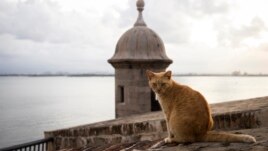06 December 2023
The US National Park Service recently announced a plan to remove hundreds of stray cats that wander historic Old San Juan on the island of Puerto Rico.
Local people and tourists consider the cats a joy, but some are bothered by them while others worry about disease.
There are about 200 cats that live on about 30 hectares surrounding the old fortress at the San Juan Historic Site. The U.S. federal agency operates the site because Puerto Rico is a territory of the United States.

FILE - A stray cat sits on a wall in Old San Juan, Puerto Rico, Wednesday, Nov. 2, 2022. The U.S. National Park Service has announced a plan to remove them. (AP Photo/Alejandro Granadillo, File)
The park service said it will pay an animal welfare organization to remove the cats. If the organization does not remove the cats within six months, the park service said it will have the cats removed.
Cat lovers are disappointed with the plan. However, the agency said that the cats can spread diseases to humans. The plan said that the removal will be of value to visitors by reducing the possibility of disease.
Ana Maria Salicrup works for the nonprofit group Save a Gato. "Gato" is the Spanish word for "cat." The group has helped care for the cats for years and hopes the agency will choose it to do the work. However, Salicrup said that the six-month time limit is not realistic.
"Anyone who has worked with cats knows that is impossible. They are setting us up for failure," Salicrup said.
There are many different kinds of cats with different behaviors that wander along the fortress known as "El Morro" which was built in the 1500s. The fortress is by the ocean and the island's capital, San Juan.
The cats are believed to have come from the time when Puerto Rico was a colony of Spain. But some were brought to the capital to kill rats in the mid-1900s by Mayor Felisa Rincon de Gautier, the first female mayor elected in the Americas.
The cats have since increased in number over the years. Visitors to Old San Juan often take pictures with the cats, and residents and volunteers with Save a Gato take care of them. The group feeds, sterilizes, and places them for adoption.
Federal officials said two years ago that area was overpopulated with cats. The smell of waste and the behavior of the cats was "inconsistent with the cultural landscape," the agency said.
Last year, the National Park Service offered two possibilities during a public meeting: remove the animals or do nothing.
Those in attendance rejected removing the cats. One man described the cats as "one of the wonders of Old San Juan." The local people have even created a statue of the cats in the historic area.
Danna Wakefield works in the solar industry and moved to Puerto Rico in 2020. She visits the cats weekly. She told the Associated Press, "These cats are unique to San Juan. Me and many other people love that walk because of the cats."
In the removal plan, the agency said that cat feeding areas are to be removed unless they are used to trap cats. It said that feeding the cats is not permitted and attracts rats. Feeding the cats also causes people to leave their own unwanted cats in the area because they know their cats will be fed.
The plan says that the animal welfare organization that is chosen will be responsible for deciding whether the cats will be adopted, placed in a temporary home, kept in a shelter or destroyed.
The National Park Service said that the six-month time limit to trap the cats might be extended if progress is made. If that does not happen, then the current plan would end, and the service would pay for a removal agency.
Salicrup said finding a home for so many cats is difficult. Save a Gato has talked with animal shelters on the U.S. mainland. They are unwilling to take the cats.
"The response always is, 'You cannot bring 100 cats here,'" she said.
I'm Faith Pirlo.
Danica Coto reported this story for the Associated Press. Faith Pirlo adapted it for VOA Learning English.
________________________________________________
Words in This Story
stray – adj. to describe going in a direction that is away from a group or from the place where you should be
wander – v. to move from one place to another without a particular direction or destination
tourist –n. a person who travels for pleasure and not for business
fortress –n. a structure for defense against military attack
welfare – n. the state of being happy, healthy, or successful; well-being
sterilize – v. to make a living thing unable to produce children or offspring
adopt –v. to legally take another person's child or pet as your own
unique – adj. used to say that something or someone is unlike anything or anyone else